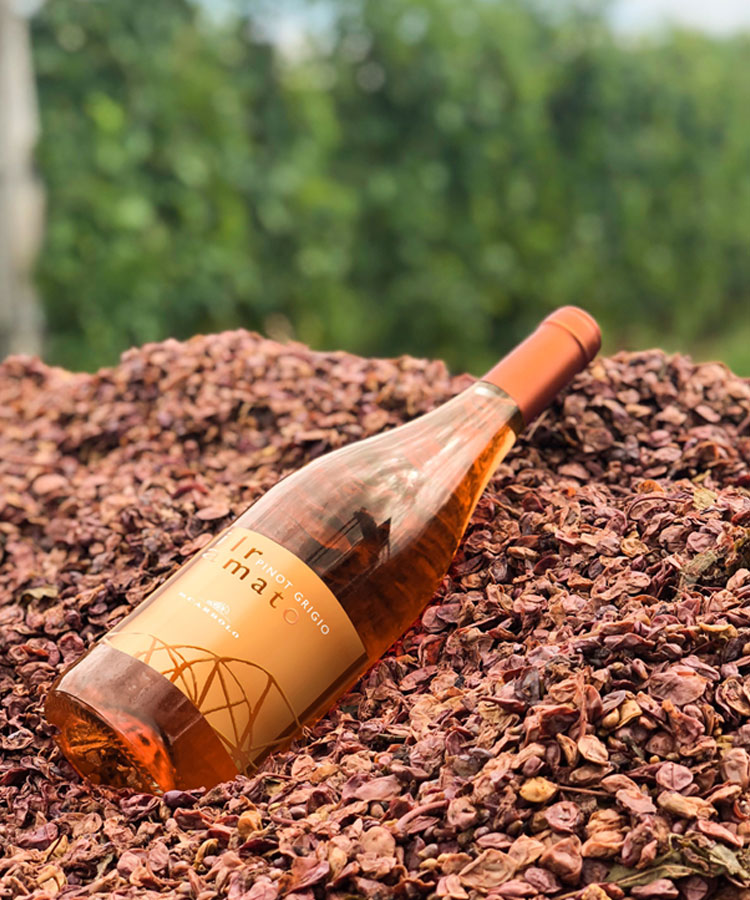
Weddings, summer picnics, dinner parties, any event involving white furniture — these are the times when a good Pinot Grigio really shines. A varietal favored by chefs, sommeliers, and discerning drinkers, this balanced blend with notes of citrus and honeysuckle originated in France as Pinot Gris (named for the grape’s gray/blue hue) and has become the second most popular white wine in America and a favorite of its Italian homeland, where it is grown and fermented in the mountainous regions of Veneto, Trentino-Alto Adige, and Friuli. But lost in translation between the vineyards of northeastern Italy and the shelves of America’s wine stores is an unusual secret — Pinot Grigio is naturally orange.
Why everyone loves this white varietal
A well-balanced wine that’s not too sweet, not too tart, Pinot Grigio pairs well with most foods but can also be enjoyed on its own. “If Chardonnay is a sequined blazer, then Pinot Grigio is a nice shirt. A sequined blazer can only be worn on special occasions, but a shirt can be worn every day,” explains Mattia Scarbolo, director of sales and marketing for Scarbolo winery, a third-generation Friulian vineyard that prides itself on crafting Pinot Grigio the traditional Italian way.

Looks can be deceiving
Pinot Grigio, a tannic white, uses the same process as a red when made in the traditional manner, with the grape skins left in tanks during fermentation, producing a vibrant orange hue. With the invention of the grape press, producers were able to avoid this process to meet rising consumer demand for Pinot Grigio. What had formerly taken anywhere from five days to three weeks, depending on the desired vinification, could now be accomplished far more quickly, this efficient separation of grape skins from their juice giving us the white translucent variety of Pinot Grigio we’re accustomed to finding in most wine stores and restaurants. But what winemakers gained in expediency, cost-cutting, and increased productivity they may have lost in flavor, nutritional properties, aroma, and, of course, color, since the longer grape skins are left steeping in the juice, the higher levels of anthocyanins vintners can expect.
Orange is the new rosé
When Mattia Scarbolo’s father came to the U.S. in the 1990s to first promote the family’s auburn-hued bottles, things didn’t initially go as planned. “Consumers thought it was rosé. Others thought it was oxidized. No one had any idea that this was the original style of Pinot Grigio,” according to Scarbolo. Americans had become so used to mass-produced Pinot Grigio that the name and product had become little more than a branding exercise. “It lost its roots, its significance, its uniqueness as one of the handful of whites with a darker skin.” But the explosion in rosé’s popularity over the last decade has opened up the market and piqued interest in orange wines, which, up until a few years ago, were largely seen as a niche curiosity. Today, orange wine’s popularity is growing in California and the Pacific Northwest as well as in the wine-rich regions of Georgia and Slovenia. Scarbolo is hopeful that the continued rise of rosé and orange wines will finally provide a route for the original Pinot Grigio to reach America’s wine glasses.

A Pinot Grigio for all palates
Scarbolo winery is based in Lauzacco, a tiny village nestled alongside the eastern hills of Friuli. The winery’s sustainable viticulture methods are a fusion of traditional growing techniques and modern technology, enhanced by the area’s diverse climate. The cold winds from the Alps and the Dolomites, combined with warm marine breezes from the Adriatic Sea and the region’s clay-based soil and unique microclimate, support a superior, slow ripening of the grapes. As a result, Scarbolo winery is able to offer a full range of whites and reds, and four expressions of Pinot Grigio, two of which are, of course, a stunning, orange hue.
Buy Pinot Grigio like an Italian, and grab yourself a bottle of Scarbolo here!
This article is sponsored by Scarbolo.
